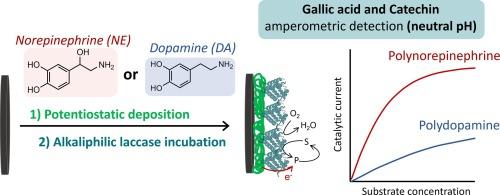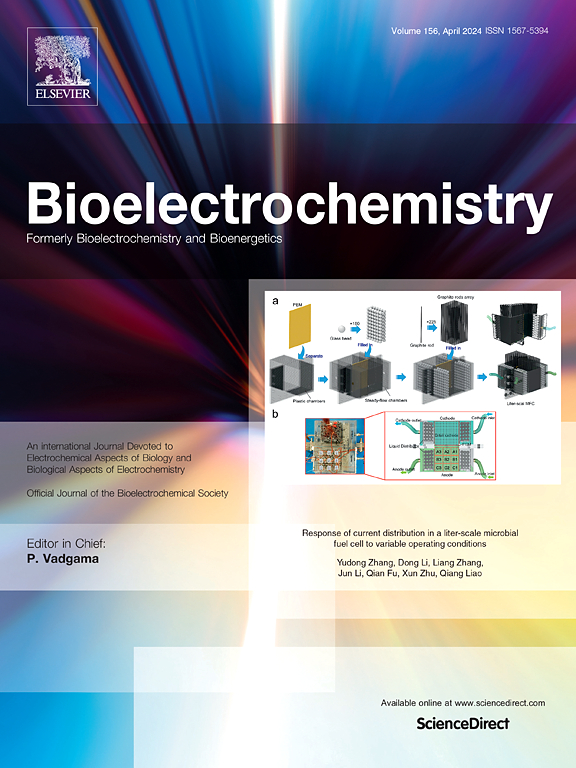用于酚类安培计生物传感器的聚肾上腺素和聚多巴胺-细菌漆酶涂层
IF 4.8
2区 化学
Q1 BIOCHEMISTRY & MOLECULAR BIOLOGY
引用次数: 0
摘要
生物传感器的成功制造在很大程度上受到其生物受体固定化的限制,因此我们提出了一种用细菌漆酶修饰石墨电极的简便且可重复的两步法,该方法依赖于一种快速且可控的电位静电过程,在石墨表面涂覆生物大分子兼容的聚肾上腺素(ePNE)和聚多巴胺(ePDA)薄膜。在酸性和中性介质中,ePNE 层可实现阴离子和阳离子物种的充分电子传递,而 ePDA 的传导则在很大程度上取决于 pH 值和氧化还原探针电荷。与 ePDA 相比,ePNE 通过改善生物传感界面对酚酸(没食子酸)和类黄酮(儿茶素)的安培反应而脱颖而出。最佳的石墨/ePNE/漆酶界面在中性 pH 值下优于基于真菌漆酶的生物传感界面,对没食子酸和儿茶素的检测灵敏度分别为 104 和 14.4 µA cm-2 mM-1。通过对 ePNE 生物启发式传导层的精细合成控制和嗜碱性细菌漆酶的使用,构建了一种安培生物传感界面,可在更宽的 pH 值范围内检测食品和农业工业废弃物中的多酚。本文章由计算机程序翻译,如有差异,请以英文原文为准。

Polynorepinephrine and polydopamine-bacterial laccase coatings for phenolic amperometric biosensors
The successful fabrication of biosensors is greatly limited by the immobilization of their bioreceptor, thus we propose a facile and reproducible two-step method to modify graphite electrodes with a bacterial laccase, relying on a fast and controllable potentiostatic process to coat graphite surfaces with biomolecule-compatible thin films of polynorepinephrine (ePNE) and polydopamine (ePDA). Both polymers, synthesized with a similar thickness, were functionalized with bacterial laccase, displaying distinct electrochemical transducing behaviours at pH 5.0 and 7.0. ePNE layer enables adequate electron transfer of anionic and cationic species in acidic and neutral media, whereas transduction across ePDA strongly depends on pH and redox probe charge. ePNE stands out by improving the amperometric responses of the biosensing interface towards a phenolic acid (gallic acid) and a flavonoid (catechin), in respect to ePDA. The optimal graphite/ePNE/laccase interface outperforms biosensing interfaces based on fungal laccases at neutral pH, displaying detection sensitivities of 104 and 14.4 µA cm−2 mM−1 for gallic acid and catechin, respectively. The fine synthetic control of the ePNE bio-inspired transduction layer and the use of an alkaliphilic bacterial laccase enabled the construction of an amperometric biosensing interface with extended pH range of polyphenols detection present in food products and agro-industrial waste.
求助全文
通过发布文献求助,成功后即可免费获取论文全文。
去求助
来源期刊

Bioelectrochemistry
生物-电化学
CiteScore
9.10
自引率
6.00%
发文量
238
审稿时长
38 days
期刊介绍:
An International Journal Devoted to Electrochemical Aspects of Biology and Biological Aspects of Electrochemistry
Bioelectrochemistry is an international journal devoted to electrochemical principles in biology and biological aspects of electrochemistry. It publishes experimental and theoretical papers dealing with the electrochemical aspects of:
• Electrified interfaces (electric double layers, adsorption, electron transfer, protein electrochemistry, basic principles of biosensors, biosensor interfaces and bio-nanosensor design and construction.
• Electric and magnetic field effects (field-dependent processes, field interactions with molecules, intramolecular field effects, sensory systems for electric and magnetic fields, molecular and cellular mechanisms)
• Bioenergetics and signal transduction (energy conversion, photosynthetic and visual membranes)
• Biomembranes and model membranes (thermodynamics and mechanics, membrane transport, electroporation, fusion and insertion)
• Electrochemical applications in medicine and biotechnology (drug delivery and gene transfer to cells and tissues, iontophoresis, skin electroporation, injury and repair).
• Organization and use of arrays in-vitro and in-vivo, including as part of feedback control.
• Electrochemical interrogation of biofilms as generated by microorganisms and tissue reaction associated with medical implants.
 求助内容:
求助内容: 应助结果提醒方式:
应助结果提醒方式:


